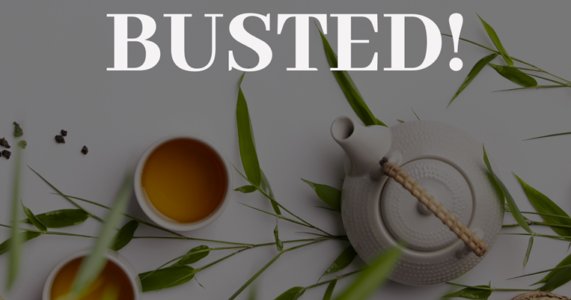Fake Tea Facts – Busted !
Tea has been refreshing the mankind for almost five thousand years. But still there are many myths related to tea and tea consumption. While educating consumers on true facts on tea, it’s equally important to make tea lovers aware on myths or fake facts on tea. Let’s look at some of myths now,

Myth 1: Herbal teas are true teas

Actually, true teas should be black, green, white and oolong teas come from the plant Camellia sinesis. Herbal teas should correctly called as “Tisanes” or “Herbal Infusions”. The term “Tisane” is the French term for herbal infusions. These Tisanes are produced by steeping fresh or dried herbs, flowers, seeds, roots or plant barks in hot water.
Myth 2: Decaffeinated tea is caffeine free

Even decaffeinated teas contain little bit of caffeine, about 2 to 10 milligrams per seving. If you do go for the caffeinated stuff, keep in mind that the amount of caffeine differs based on tea grade size. Smaller the size, higher in caffeine. For example, fine matcha green tea powder contains few times more caffeine compared to other regular tea grades.
Myth 3: Rinsing tea leaves removes caffeine.

This is a general practice in a Chinese tea ceremony. Rinsing tea for a few seconds will slightly reduce the amount of caffeine, but since 80% of caffeine released in the first couple of minutes of infusion, this claim is not fully true. During this quick wash, a major portion of the flavour is also released, so it’s not recommends doing a long wash since it will result in a very unsatisfactory drink with a poor sensory profile. Instead, just go for a drink which is naturally lower or free from caffeine.
Myth 4: Black Tea has the most caffeine

Black tea has the highest level of oxidation, but that doesn’t mean that black tea is higher in caffeine. As explained earlier, only catechins are converted in to heavier polyphenols during black tea processing. Various factors determine the caffeine content in a tea brew; from grade size, where the tea is grown, to the type of leaf, when it is harvested, and brewing technique for the end experience.
Myth 5: Leaf tea is healthier than small leaf tea.

Most tea consumers think that small leaf tea is inferior to long leaf tea. This is another false statement. According to an experiment conducted by Mr. Ian Bersten at Hangzhou Tea Academy, All-China federation of supply and marketing cooperative on 27th September 2009,
- After pouring 1.5g of Green tea fannings for 30 seconds released more antioxidants (12.9g per 100g) compared to pouring 3.0g of long leaf tea for 3 minutes (9.5g per 100g)
So no matter whether you prefer long leaf tea or broken grades, both are healthy!
Myth 6: Tea has higher levels of Aluminium

This is yet another false fear among tea drinkers. The bio availability of aluminium in tea is around 0.37% which is not significantly differ from water (0.30%). In general aluminium content in immature leaves used to manufacture tea is much lower compared to coarse leaves.
Myth 7: Hot tea is better than cold tea

This is not quite true. Studies demonstrate that home made iced tea has the same benefits as hot tea. But during pandemic and if you’re suffering from cold or fever, it’s always better to consume hot tea.
Myth 8: Tisanes are safe during pregnancy

Many pregnant mothers avoid regular tea and consume more tisanes instead. But those aren’t all necessarily safe. Some tisanes contain ingredients which either haven’t been fully investigated or may have a bad effect on the fetus. It’s better to consult a registered dietitian or doctor before drinking tisanes when you’re expecting.
Myth 9: Drink as much tisanes as you want

This sounds nice, wouldn’t it. Sadly, it’s not the case. Some tisanes have more in which can cause harmful effects. For instance, Hibiscus infusion lowers blood pressure, but too much of this brew could cause problems by lowering blood pressure too much. Senna is another as too much of it could lead to dehydration.
Myth 10: Drinking green tea will burn fat

Without knowing true facts, green tea has been hyped up as a magic weight loss solution. This myth’s arrives from the fact that green tea contains a stimulant that does speed up metabolism—but only a little amount. Also tea lovers think that green tea antioxidants can contribute to weight loss. Be careful, If you imagine sipping green tea or popping supplements is the answer. Green tea contains caffeine, that may be dangerous if you have a poor heart condition. Other than that, green tea supplements can react with other medications. In order to burn fat, you should couple healthy diet rich in antioxidants (Including pure teas) with regular exercises.
Myth 11: Tea doesn’t have an expire date

If you have tea bags or packets sitting around for years, it’s better to toss them. In order to have a good tea experience, you should consume tea within 6 months following the packing date. Over time, flavour compounds and the powerful antioxidants found in tea are reduced. To get the most out of your tea, store it in a cool, dry and dark place.
Myth 12: Tea bags are as good as loose tea

It is convenient to make tea using tea bags. In general, poorer teas are used to manufacture tea bags since the tea is not visible. Also, you get the filter paper taste after brewing tea with tea bags. You might think that nylon tea bags would be a better choice, but while brewing pyramid tea bags, micro-plastics can be released in to the brew. So it’s always better to use loose leaf tea.
Myth 13: Green tea is healthier than black tea

Green tea is indeed perceived as a healthier tea type compared to black tea, but, apart from this there is no other difference. Both contain powerful and beneficial antioxidants.
Tea leaf color is changing from green to black after going through oxidation process. During this manufacturing process, antioxidants available in green tea, such as catechins, are converted into the theaflavins and thearubigins that are found in black tea. No artificial stuff is added during black or green tea processing.
Myth 14: Adding milk to the tea neutralizes its health benefits

It’s true that you need to consume tea in it’s pure form in order to obtain it’s maximum benefits. But adding milk to any kind of tea will not remove its health benefits. Milk contains calcium, that is beneficial for your bones. According to a study published in the Journal of Agricultural and Food Chemistry, the number of catechins absorbed from tea may remain the same whether you add milk or not.
Myth 15: Certified organic tea is higher in quality

Organic tea cultivation is a method of production where there is no use of synthetic agro-chemicals, from bush to cup, and it is setting itself up as a healthy lifestyle ethical standard. Organic cultivation is indeed a sustainable method and it minimizes the damage to the environment and living beings. But whether tea is produced organically or not, it’s quality and the sensory characteristics are determined by an evaluation of flavour, aroma and taste. Elevation / altitudes, harvesting time, leaf type, etc. are some of the conditions which craft a rich tea-experience. Many high-quality, delicious teas do not come with organic certification or standard.
The truth is, organic certification or standard is just a label provide to guarantee sustainable agriculture practices. There is nothing wrong of paying a premium for organic tea. Many large plantations are leveraging off the organic title while many small holder tea gardens, which can’t afford the certification, have mastered the craft of premium quality tea through traditional agricultural practices alone.
Myth 16: Tea dehydrates our body

This is not true at all. The first thing to mention here is that tea contains more than 99.5% of water, boiled, flavored or otherwise, it’s water. It’s true that Tea is mild diuretic and has less caffeine compared to coffee, that does not mean that more water is leaving our body than is being used. Having adequate water will keep you away from dehydration. Stay Hydrated, drink more tea!
Myth 17: Slurping tea is rude

Slurping tea may be bit unpleasant to the people around you, but by slurping tea, you’ll mix the tea with more oxygen in your mouth. It allows you to pick up way more aroma! and it cools the tea down. Professional tea tasters also follow the same technique. it allows the aromatic aromas to escape the liquid as well. Light slurping can give a better pleasure while sipping compared to aggressive slurping.
Myth 18: The Tea Bag Was Invented by Accident

Its widely believed that Thomas Sullivan accidentally invented the tea bag when he utilized it as a means to transport the correct quantity of tea samples to his buyer who just added tea bags to his pots. But, records demonstrate that before this incident two women namely Roberta Lawson and Mary McLaren submitted a patent in 1901 for what is considered to be the modern Tea bag.
View More Latest Tea News + Articles: http://www.teawithnipun.com/




February 18, 2023 @ 9:19 am
Nice review of Tea Myths, Nipun – and there are still plenty more out there to bust!
February 19, 2023 @ 6:10 am
Thank You So Much Mr. Nigel !
February 18, 2023 @ 1:21 pm
Great article and useful facts ,
February 19, 2023 @ 6:11 am
Thank You So Much Charles !
February 19, 2023 @ 8:18 am
The one I would disagree with is Tea having an expiration date, loose tea will never ever expire. Some tea like green tea is best in the first year or so, but I have had aged green tea which was a very interesting experience. Some tea will get better, some will not, but it will never actually go bad. But this only applies to Camilla sinensus. Puerh, Heicha, oolong, and white tea are all intentionally aged as well.
February 19, 2023 @ 10:40 am
Valid point Ken ! Thank You for Sharing Your Opinion ! Yes Pu-Erh is an exception. May be packs should mention Best Before rather than mentioning as expire date.